Remington’s Metric Rimfire: Stepchild or Genius?
By
Russ Gould
The year was 1970. Rhodesia declared independence from Britain setting the stage for a chain of events that are still unfolding 38 years later; the US Army charged 14 officers with suppressing information relating to the My Lai Massacre; the Concorde made its first supersonic flight; and the Beatles disbanded after releasing their last album, “Let it Be”.
1970 was also the year that Remington introduced their 5mm Remington Magnum cartridge, 11 years after Winchester launched the successful 22 Magnum. The 5mm was a revolutionary cartridge. First, it was an unique metric bore diameter in a country still firmly entrenched in the Imperial system of measure. Second, it was a bottleneck rimfire cartridge. And third, it was an entirely new cartridge, not a derivation of anything extant. Along with the cartridge, Remington brought two rifles to market, the clip-fed 591 and the very similar tube-fed 592. The new round was loaded with a long-for-caliber 38 grain jacketed bullet with a jacketed hollow point bullet, rated at 2100 fps or about 100-150 fps faster than the 22 Magnum. Given the quality of the 22 Magnum ammo available at the time, the new round was not only flatter shooting, but inherently more accurate. It looked like a very promising development. Guns and Ammo ran a side-by-side test of the new round and it’s bigger brother, an article I clearly remember reading nearly 40 years ago. I can’t put my hands on it now, but if I recall correctly, the writer found no clear advantage to the either round. The 5mm was a little faster and reached out a little further, but the 22 Mag was a little heavier and made a bigger hole. For some reason, the accuracy angle wasn’t developed in the article. Lacking a clear performance advantage, and considering the fact that 22 Mag ammo was considerably cheaper and was chambered, relatively speaking, in a plethora of different rifles, it was no surprise that the 5mm was a marketing flop. Remington had made the mistake of developing a solution to a problem that did not really exist, and they failed to differentiate their new offering along any dimension that the market really cared about. Finally, they compounded those mistakes by keeping the round proprietary. (Only Thompson Center offered barrels in 5mm for their Contender, itself a quirky idea that somehow survived and prospered largely due to the large selection of interchangeable barrels available for it.) One wonders what would have happened had Anschutz offered a rifle for the new round.
Shortly after it was launched, Remington stopped making rifles and then in 1981, ten years after introducing the cartridge, they halted ammo production. This left owners of the rifles high and dry. An outfit by the name of Schroeder Bullets developed conversion kit, that would allow the rifle to be converted to center fire use, utilizing special cases and bullets supplied by the same company.
On several occasions in the intervening 38 years, I have toyed with the idea of purchasing one of these Remington rifles with the intent of converting it to the center fire version of the cartridge, using the special conversion kit. If I happened to own a rifle in the caliber, I probably would have done it. That not being the case, I couldn’t motivate myself to go to all that trouble. So it was not until 2008, when Aguila of Mexico introduced fresh factory ammo in this caliber under the “Centurion” brand, that I indulged my desire to get to know the little cartridge.
Let me qualify what I am about to say by admitting that I don’t own a 17 HMR and have never shot a rifle in this caliber. The reported accuracy of the 17 “Hummer” and it’s flat trajectory intrigue me somewhat, but the high price and initial shortage of ammo gave me pause. I have also read that the tiny bullet loses effectiveness rapidly beyond 100 yards, whereas the newer 22 Magnum offerings are more powerful and accurate than ever. So for my purposes, I have stuck with the proven 22 LR and 22 Mag for my rimfire shooting, seeing no compelling reason to jump on the 17 bandwagon. Thus, half of what I am about to say next could probably also be said about the 17 HMR.
I purchased 1000 rounds of the Aguila “Centurion”, thinking that if this was a limited run, I would stock up and could always sell the surplus if need be. It wasn’t cheap, at about 50% more than the price of 22 Mag ammo, putting it well above the price of 17 HMR fodder which is now plentiful. Now that I owned the ammo, I needed a rifle! A little online shopping turned up a 591 with a spare clip, topped with a period Weaver V-22 scope. The owner also included a half dozen original Remington cartridges at my request. I would use these a reference for the new ammunition.
The rifle arrived a few days later and I looked it over with anticipation. It was a full size rifle, unlike many rimfires, and it had a serious-looking lockup system on the bolt, reminiscent of the Remington 788 with multiple locking lugs at the rear and the resultant short bolt throw. The extractor blade is an oddity, exposed on an angled camming surface at the rear end of the barrel. Upon closer inspection, there are actually two extractors. The first one floated in the action and was flush with the chamber, allowing the case head to be fully supported. This first extractor was not part of the bolt, but rather part of the action, and its function is to extract the case about 1/10” until the main extractor, which is cammed out of the way while the bolt is closed, takes over. This design eliminates the normal extractor cutout at the rear of the chamber. I surmised that the higher pressure of the new round called for a “fully enclosed” cartridge head and a new extractor design. The rifle was otherwise quite plain, apart from a very 70’s plastic grip cap sporting the “5mm Remington Magnum” descriptor. Aside from a very hokey plastic shroud over the first inch of the barrel through which the rear iron sight is screwed to the barrel, whose purpose fully escapes me, quality of the rifle appeared to be excellent by rimfire standards.
That same afternoon, I opened up a box of the seductive little cartridges and set up my chronograph to see what the rifle could do. The soft/hollow point Aguilas left the muzzle with a very sharp crack and recorded velocities of 2297, 2317, and 2277 fps for 3 successive rounds! This was quite a bit faster than the original Remington factory spec of 2100 fps, due no doubt to the use of a lighter 30 grain bullet. Accuracy was very good at a hair under an inch for 5 rounds at 80 yards. I repeated the exercise with the few vintage Remington rounds I received with the rifle. The bullets were conventional jacketed hollow points with scored jackets for rapid expansion. Velocity was 2077, 2048 and 2068 fps and accuracy (and point of impact) were for all intents and purposes identical to the more modern ammo.
I then attempted to pull a bullet from each brand of ammo but found the original Remington bullets so soft that the front half just tore away from the shank of the bullet, which was heavily crimped into the case. The Aguila offering had no crimp and yielded to my efforts, spilling a pinch of ball powder onto the shooting bench.
The proof of the pudding is in the eating, so I was keen to test the 5mm on some critters. The following weekend, we packed up the SUV and headed for the hills of Central Oregon, or more precisely for an alfalfa field in those hills that I knew to be overrun with sage rats. The price of the ammo in the trunk was overshadowed by the price of gas at the pump! When we arrived, we were somewhat dismayed to note that the alfalfa was now boot high, concealing the squirrels from our view. However, we found an area where the crop was slow to take off for whatever reason, leaving the rats exposed and vulnerable. My son and I set up the shooting positions and commenced fire, my with the 5mm and he with his 222.
Contrary to what has been written elsewhere, I found the trigger on the Remington to be quite good…crisp and without much overtravel. The scope, however, left something to be desired. Even at 7 power, the clumsy crosshairs obliterated the rats making precise shot placement a little tricky. However, I soon got the hang of it and rats began falling to crack of the rifle. Having shot this same field about a month earlier with a 22 LR, I immediately noticed that the rats folded at the report, with no apparent delay as with the LR. Instead of the crack,clatter …. whop of my Ruger 10/22, the sequence was now blam-thwack. The words “death ray” came to mind. Not only did the rats fold almost instantly, but upon close inspection most were totally eviscerated by the little round. There was no crawling off and very little wriggling at the receiving end. The rifle barked and the rats dropped pretty much on the spot. The exposed lead hollow points were clearly opening up with gusto on impact, and the results were pretty consistent all the way out to 150 yards. I held a little low inside 100 and a hair high past 125. The rifle called for better glass, as it clearly had the potential to reach out a little further. All the way to 200 I suspected. With the V-22 Weaver, the rats were obliterated by the reticle at that range. I made a mental note to dig through my pile of scopes for something more appropriate…a 10x perhaps, with a fine crosshair.
Around the campfire that evening, I had time to collect my thoughts: here was a very effective and accurate round that was fun to shoot, worth every penny of the quarter dollar per round price. It clearly outperformed the 22 Mag in this application. It was on a par with the Hornet, on rats at least. How could such performance have failed to ignite the same interest and to achieve the same instant success that the 17 HMR had achieved, some 30 years later? Part of the answer lies with the new higher velocity ammo, for sure. Part was the limited availability of rifles. And a good measure had to do with Remington’s notoriously poor marketing. The round landed in the same reject heap as the 222, the 244, and the 350 “short mag”, all excellent cartridges that were eclipsed by Winchester’s similar offerings.
What does the future hold for the little metric rimfire? It seems unlikely to succeed now that the 17 HMR has been so widely accepted. I can’t speak from personal experience, but if what I have read is true, this round is a more humane killer than the 17 HMR, and it may just have enough thump to take out woodchucks and foxes, something the 17 isn’t really up to. Without some decent new rifles chambered for the round, the Aguila ammo is surely going to be a temporary run. This will require quite a bit of engineering on the part of the rifle manufacturers. (And therein lies the genius of the HMR…almost any 22 Mag design could easily and quickly be modified to chamber it.). There is talk of new rifles coming to market in the 5mm…with CZ being the name mentioned most often. Remington has denied any plans to reintroduce rifles in this caliber. So if it does succeed in making a comeback, Remington will have mud in both eyes. Chambered in a nice varmint-style rifle like the heavy barrel CZ, the very dead 5mm may rise like Lazarus. In the meantime, I have a new favorite rat rifle, and a pile of ammo to burn.
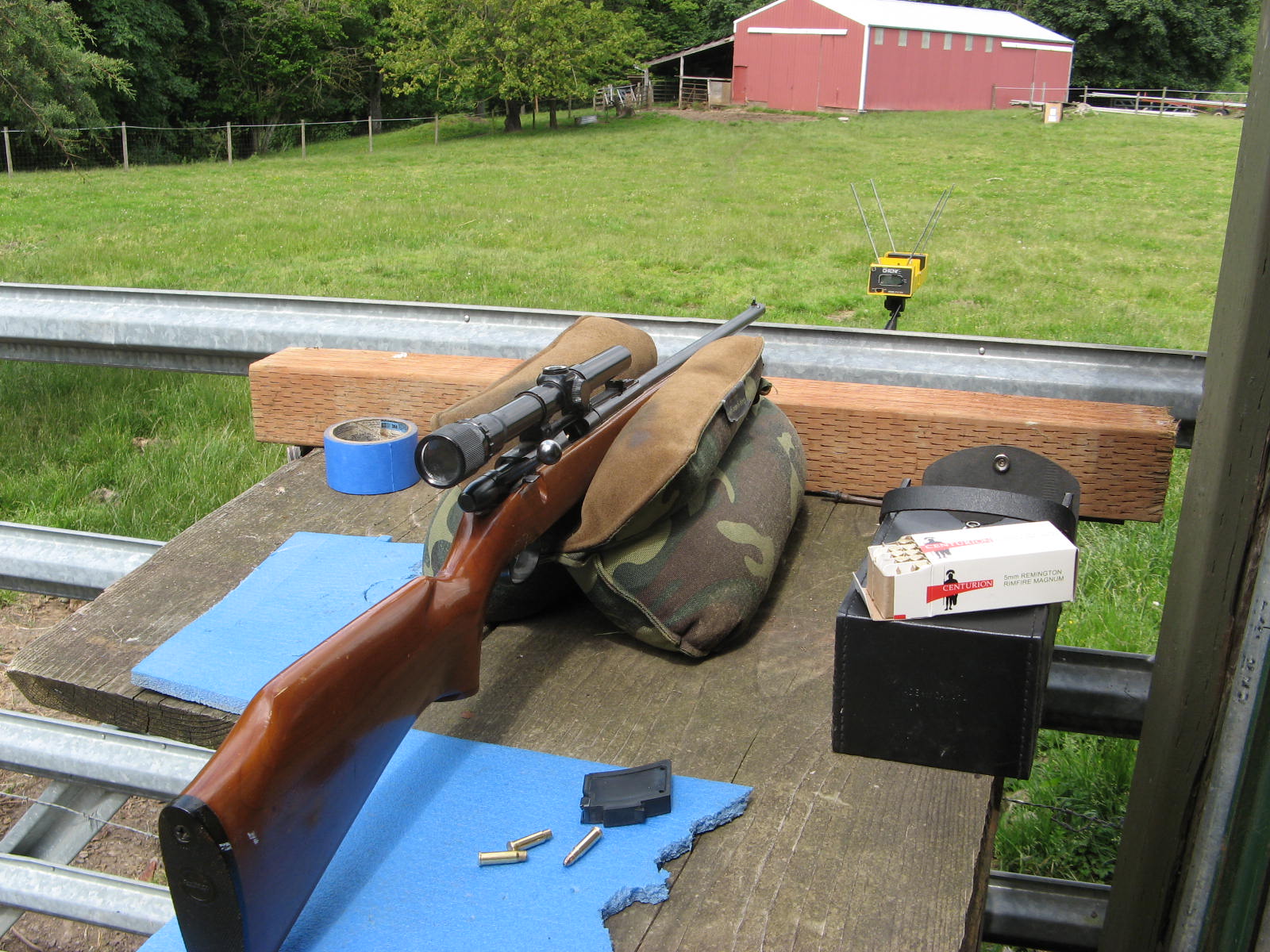 Rifle, ammo and chrony - an afternoon of discovery at the range
Rifle, ammo and chrony - an afternoon of discovery at the range
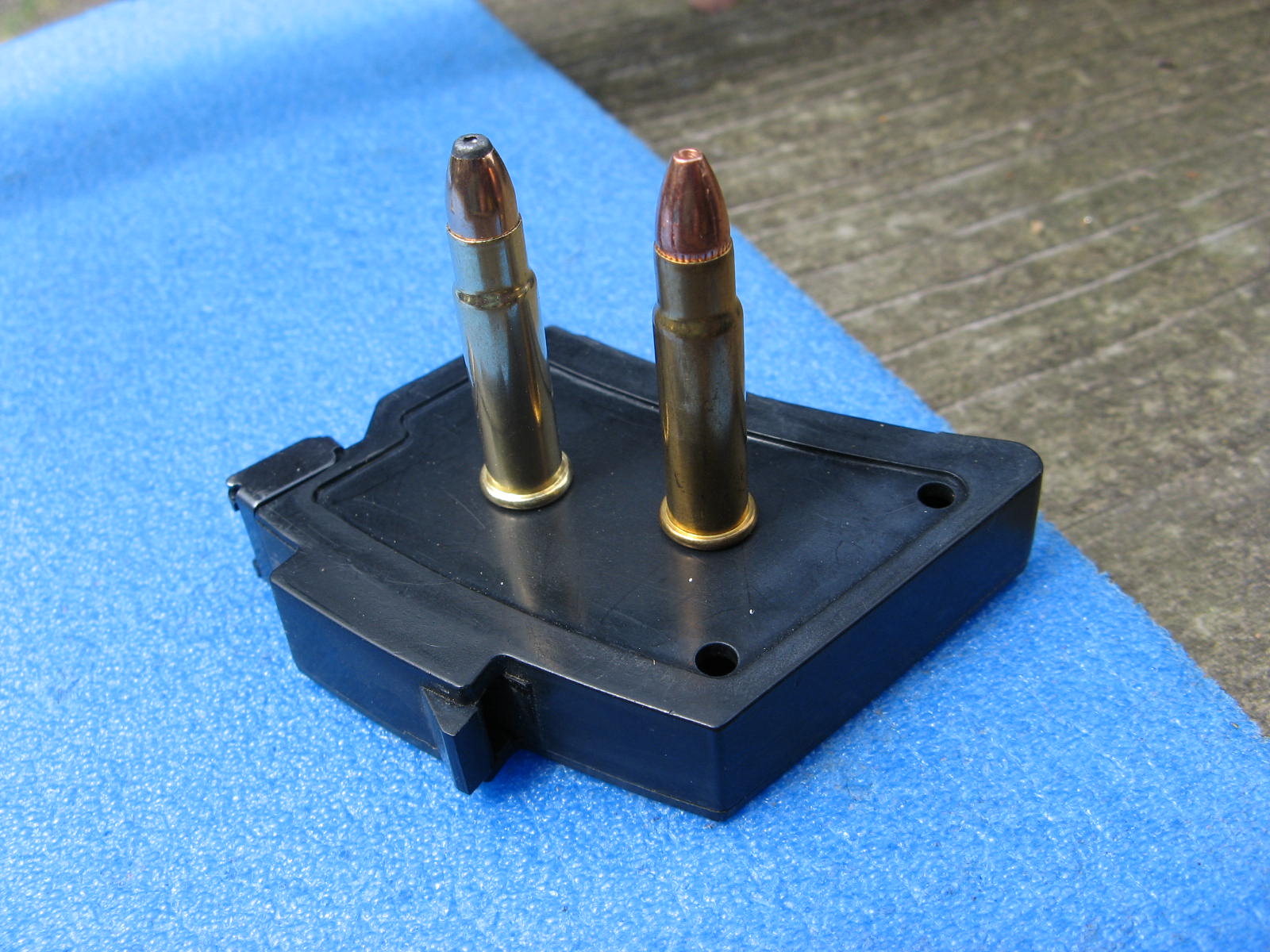 The new Centurion 30 grain loading, alongside the veteran Remington 38 grain round
The new Centurion 30 grain loading, alongside the veteran Remington 38 grain round
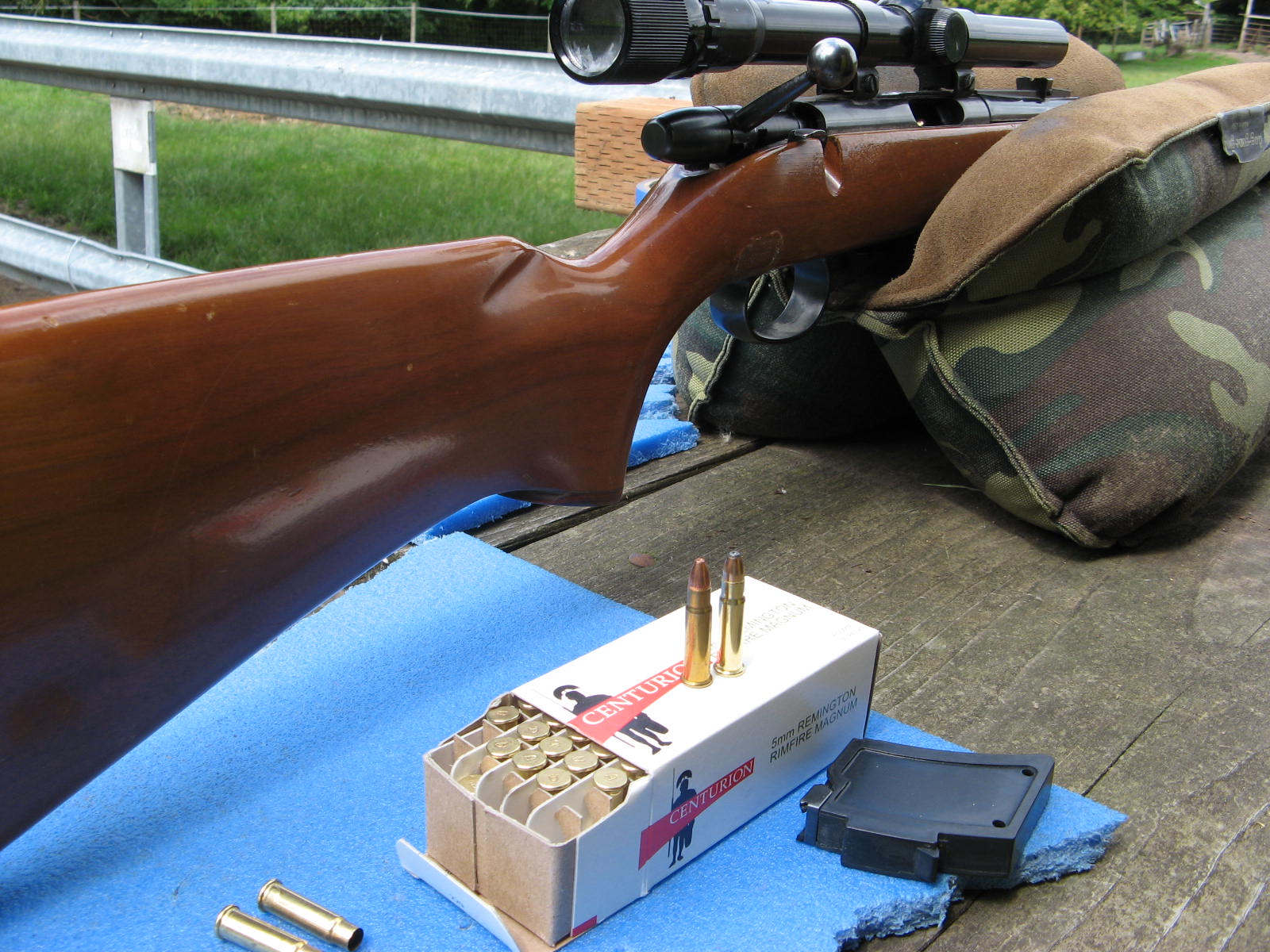 Centurion ammo as manufactured by Aguila
Centurion ammo as manufactured by Aguila
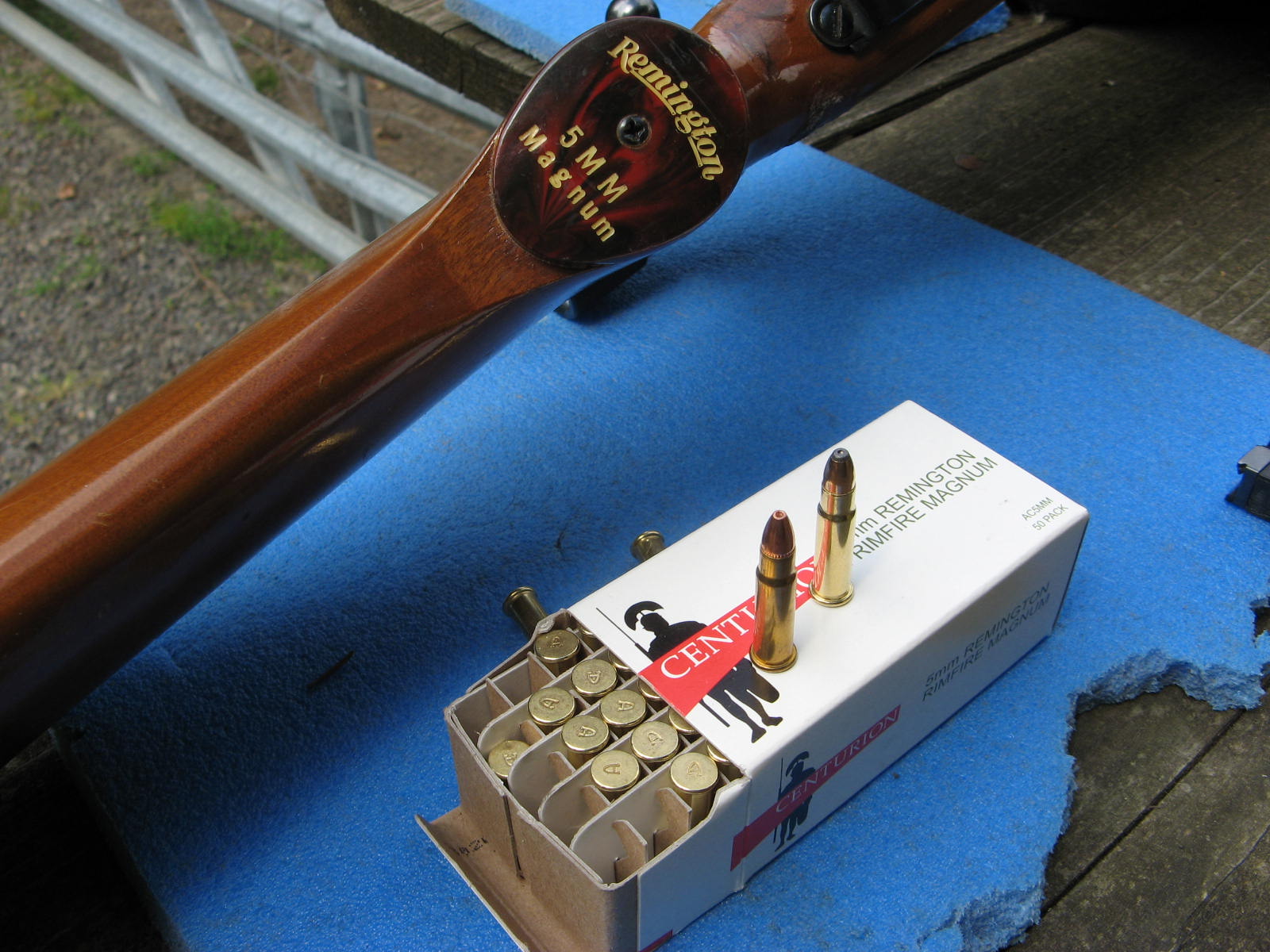 Seventies marketing … a gee whiz plastic grip cap on the Remington 591
Seventies marketing … a gee whiz plastic grip cap on the Remington 591
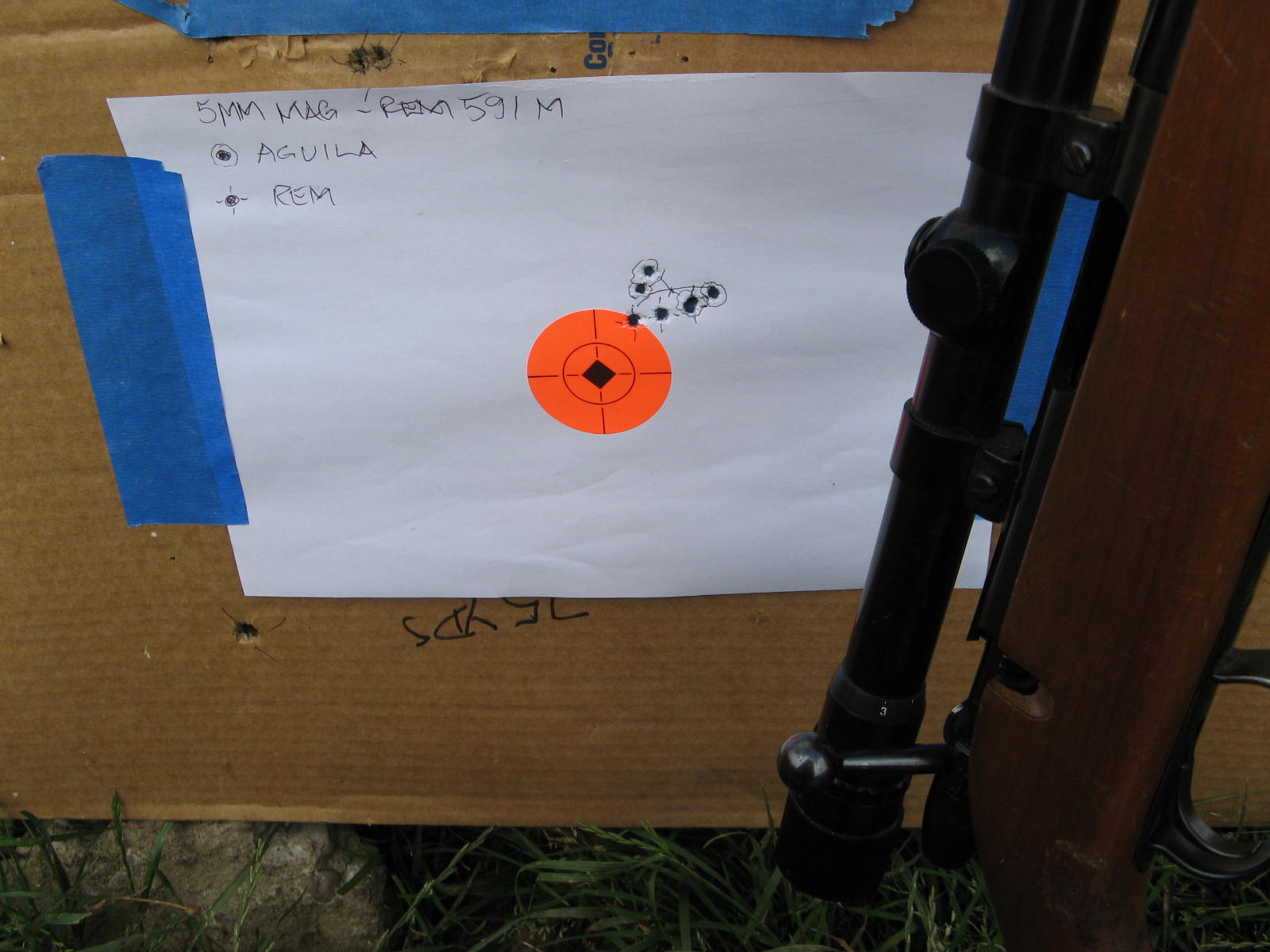 Surprising results with old and new ammo
Surprising results with old and new ammo
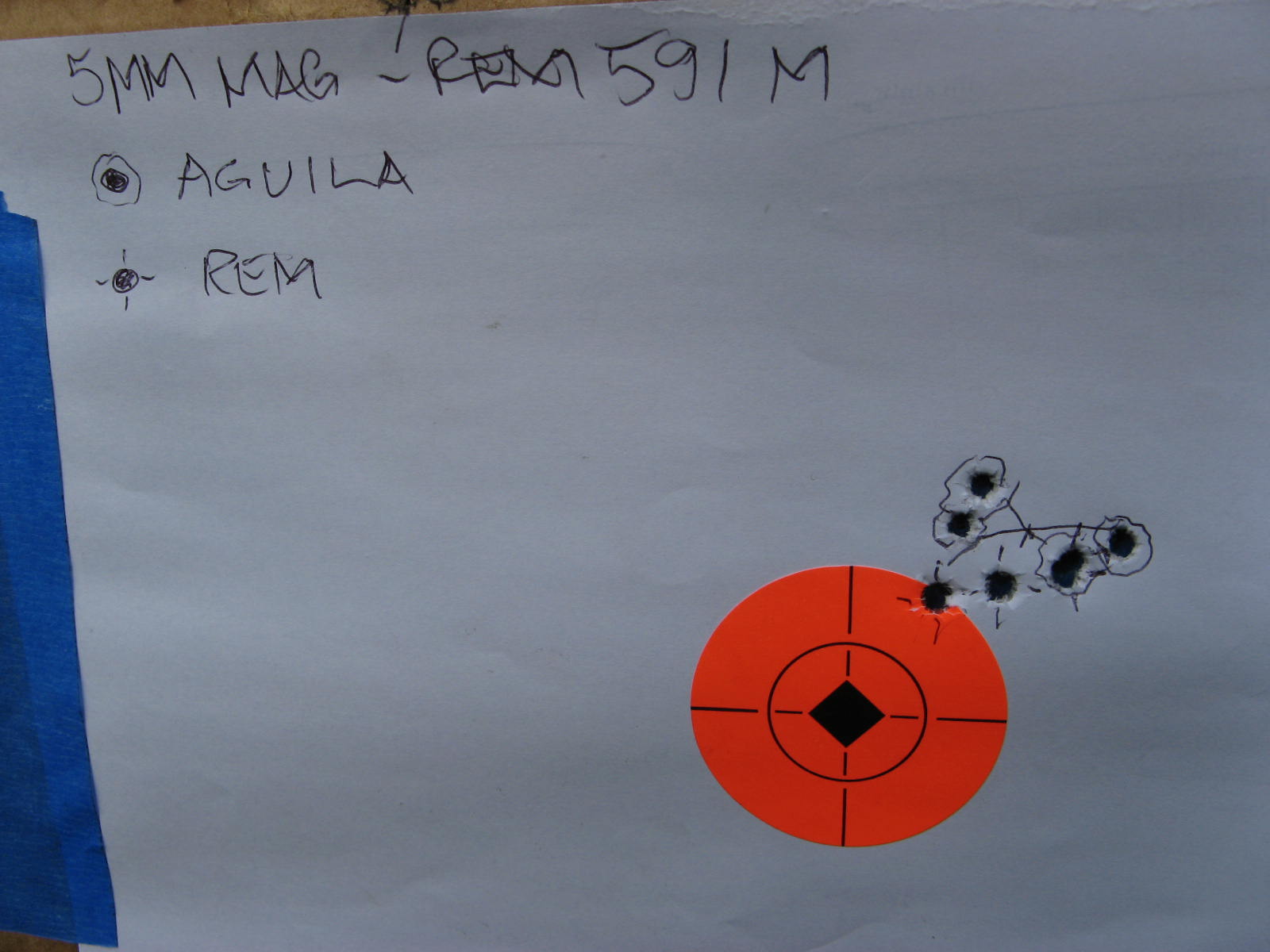 Old and new shoot to almost same point of aim
Old and new shoot to almost same point of aim
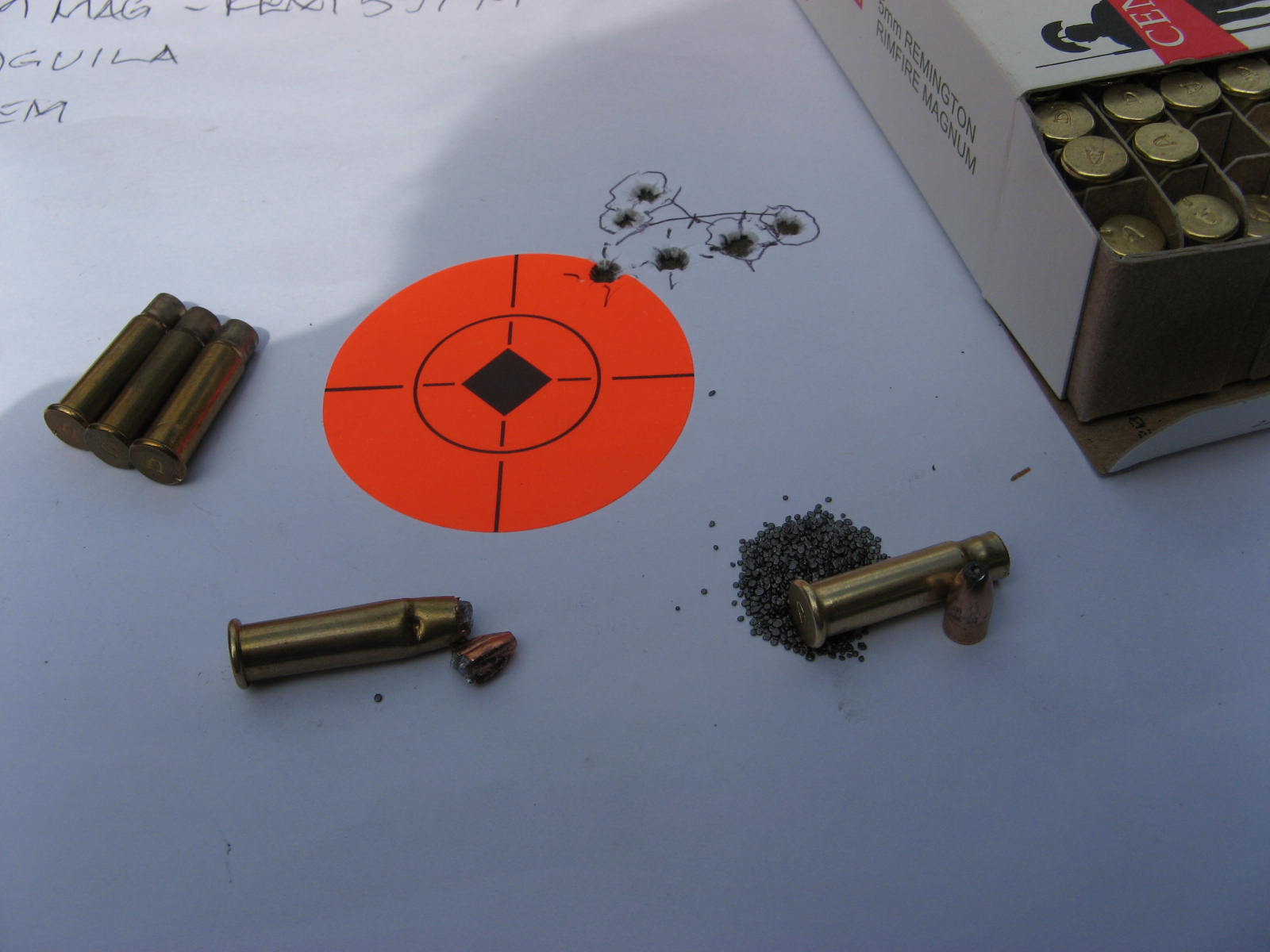 Aguila ammo did not utilize the same heavy crimp of the original round
Aguila ammo did not utilize the same heavy crimp of the original round
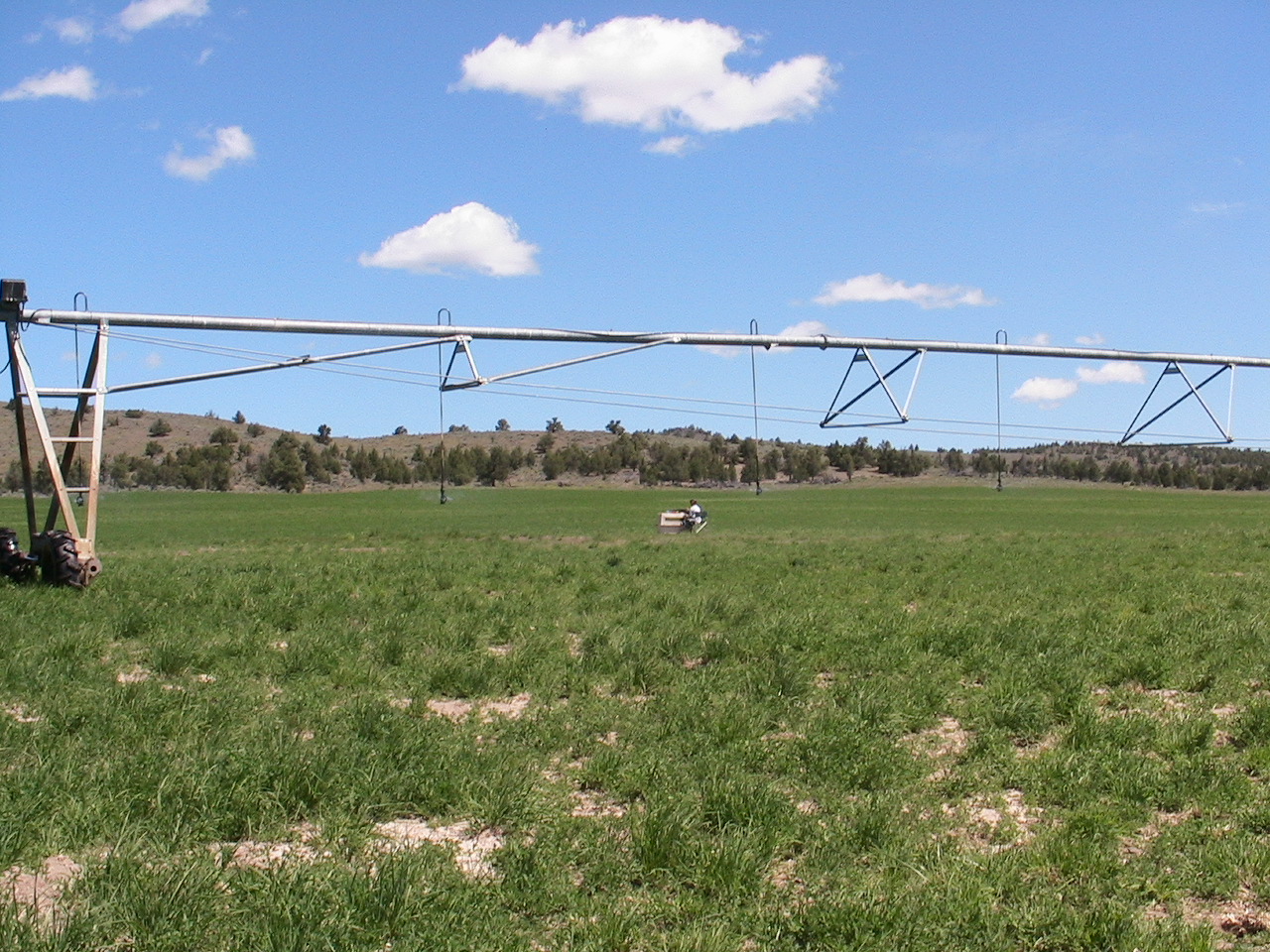 A summer afternoon in Central Oregon
A summer afternoon in Central Oregon
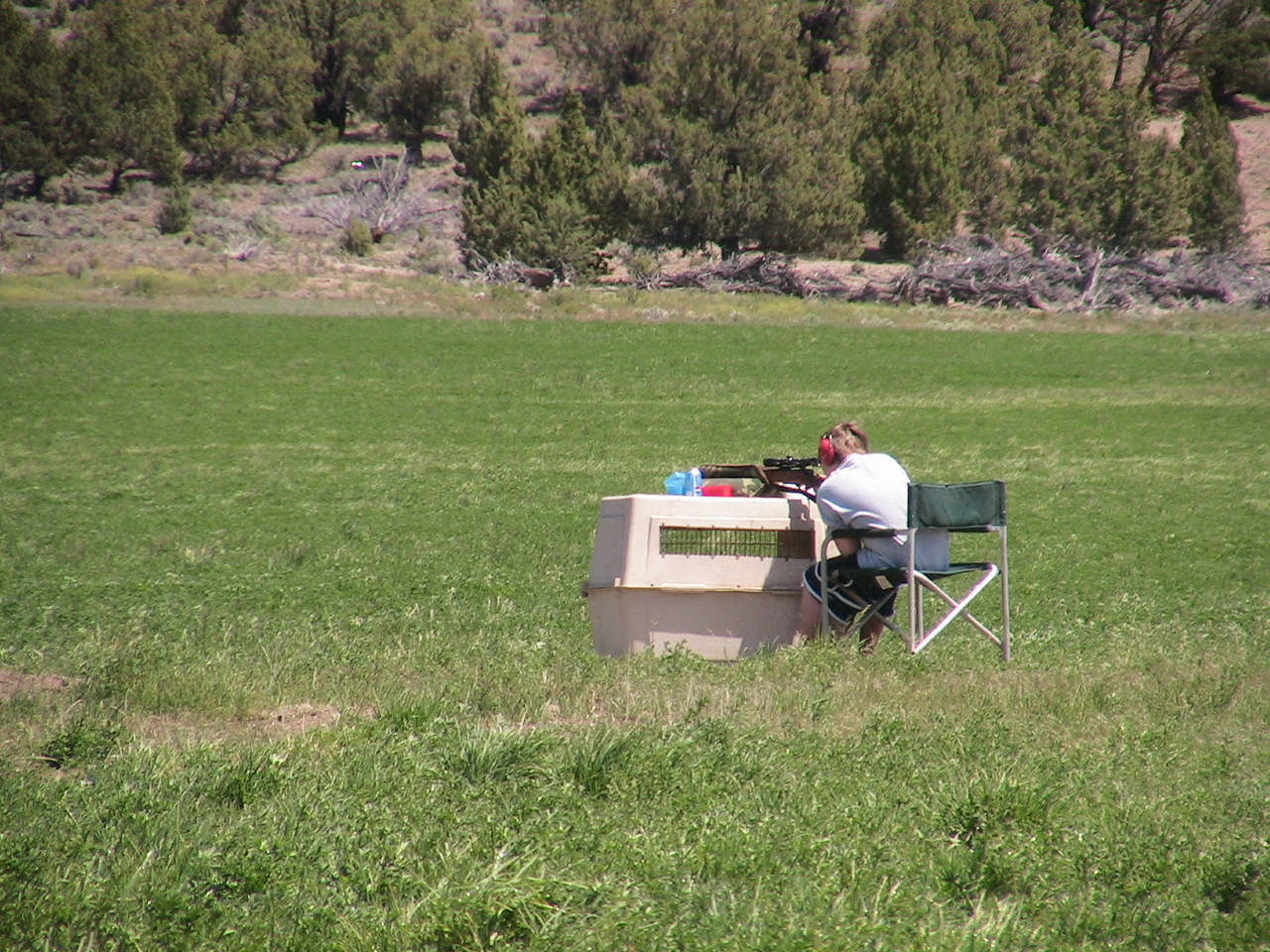 Junior shooting rats
Junior shooting rats
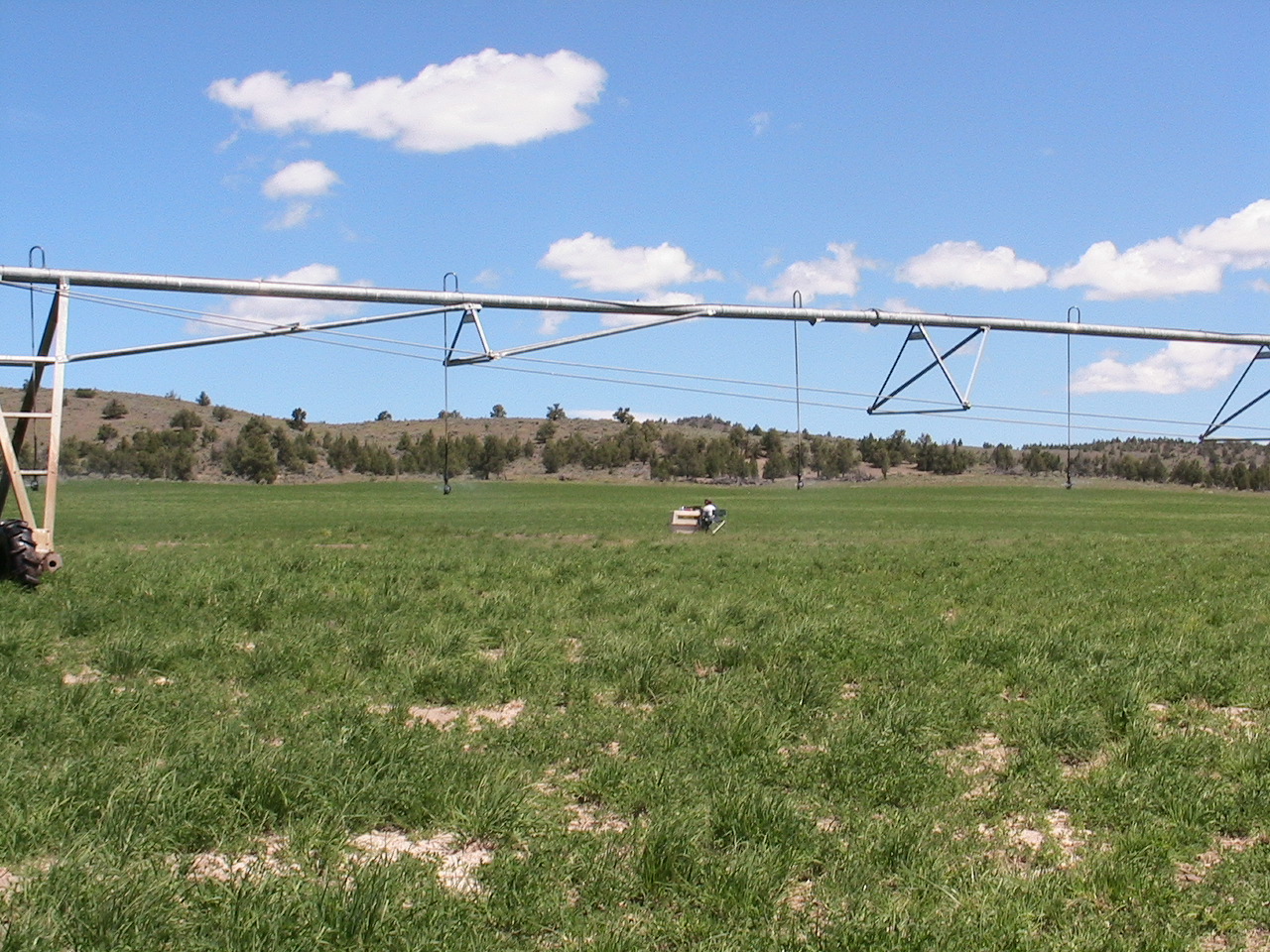 Clouds
Clouds
 A break in the action
A break in the action
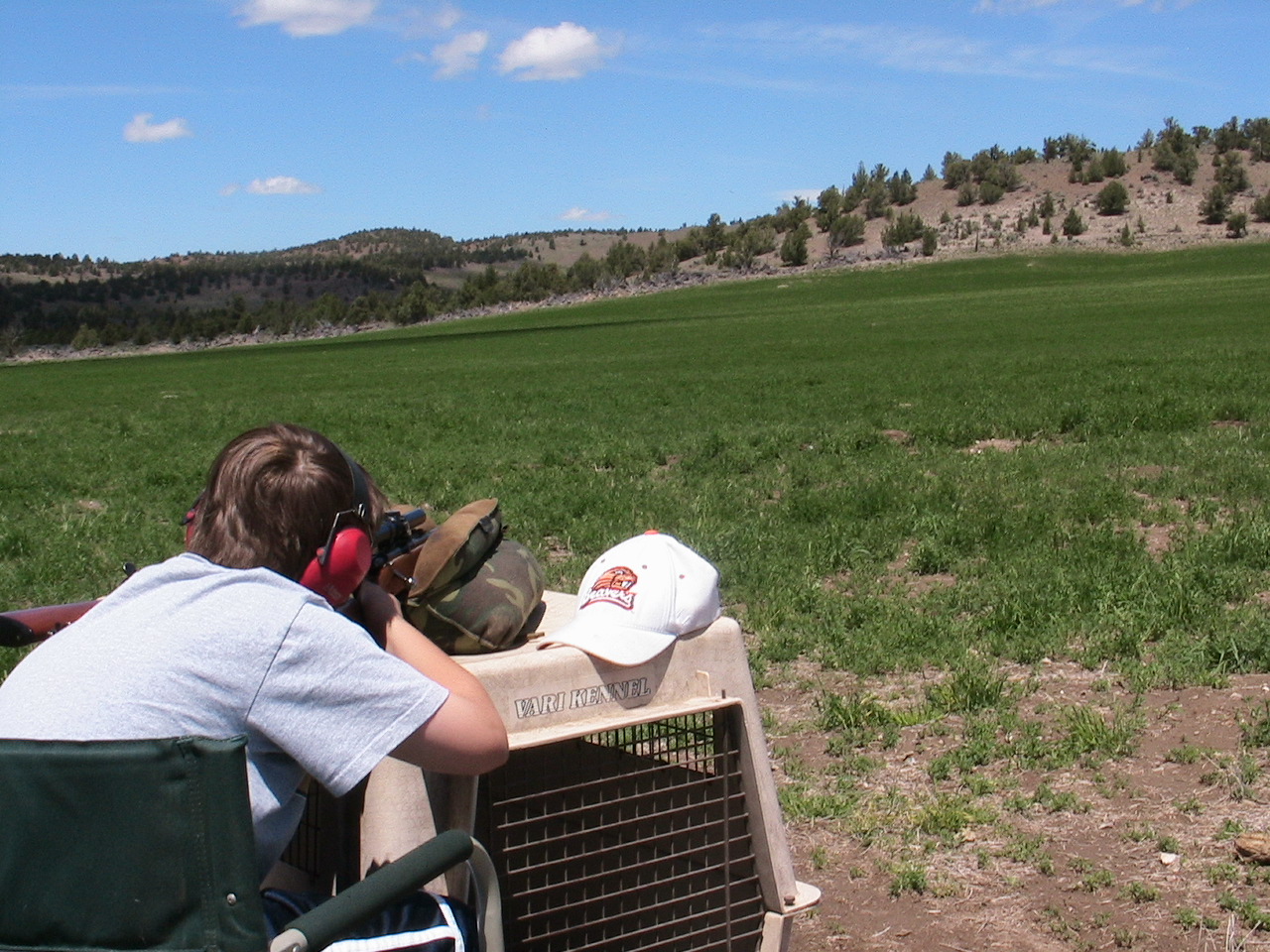 Boy with rifle … and all is right with the world
Boy with rifle … and all is right with the world
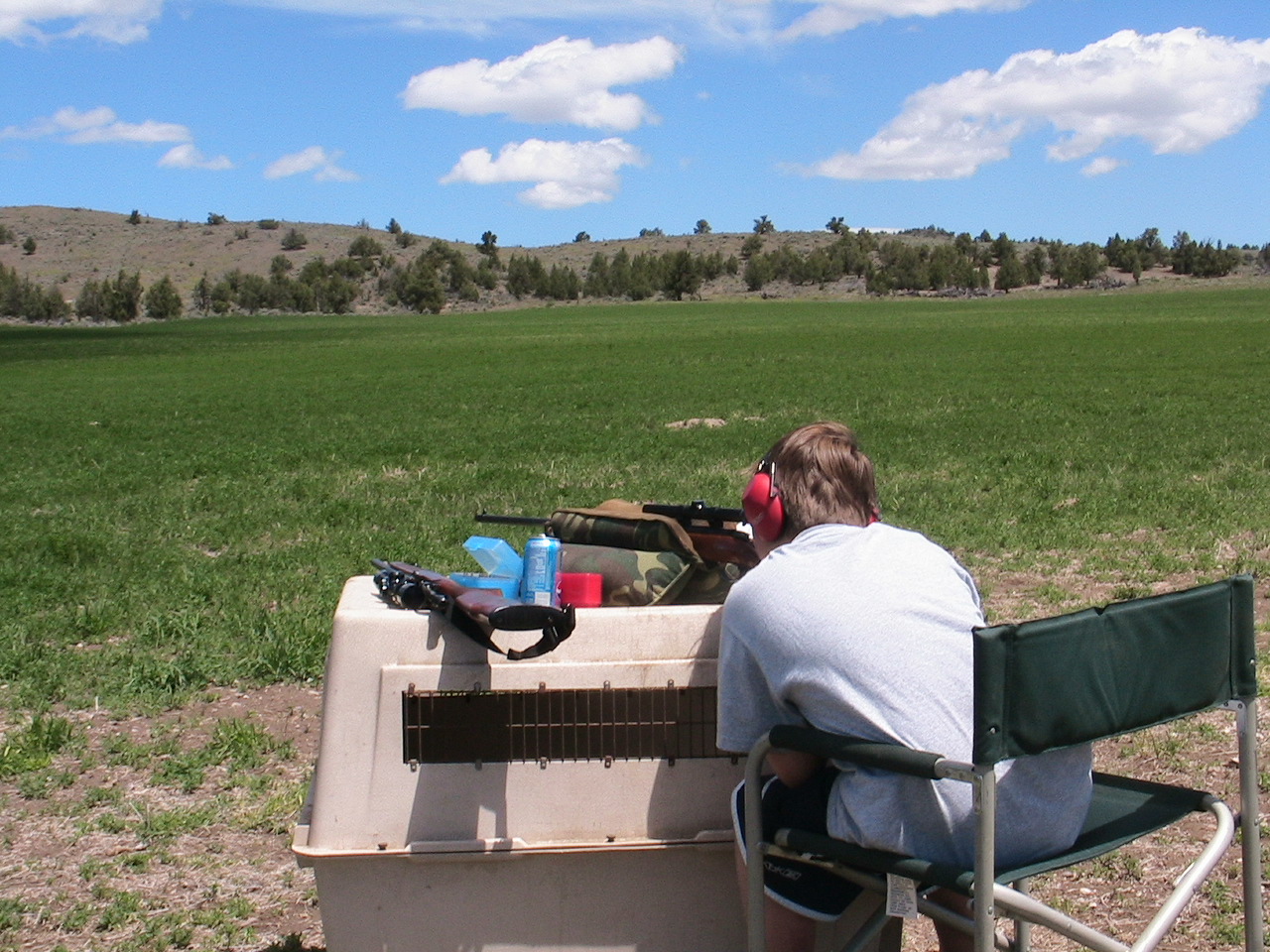 Let’s see if this thing shoots as well as my 222
Let’s see if this thing shoots as well as my 222
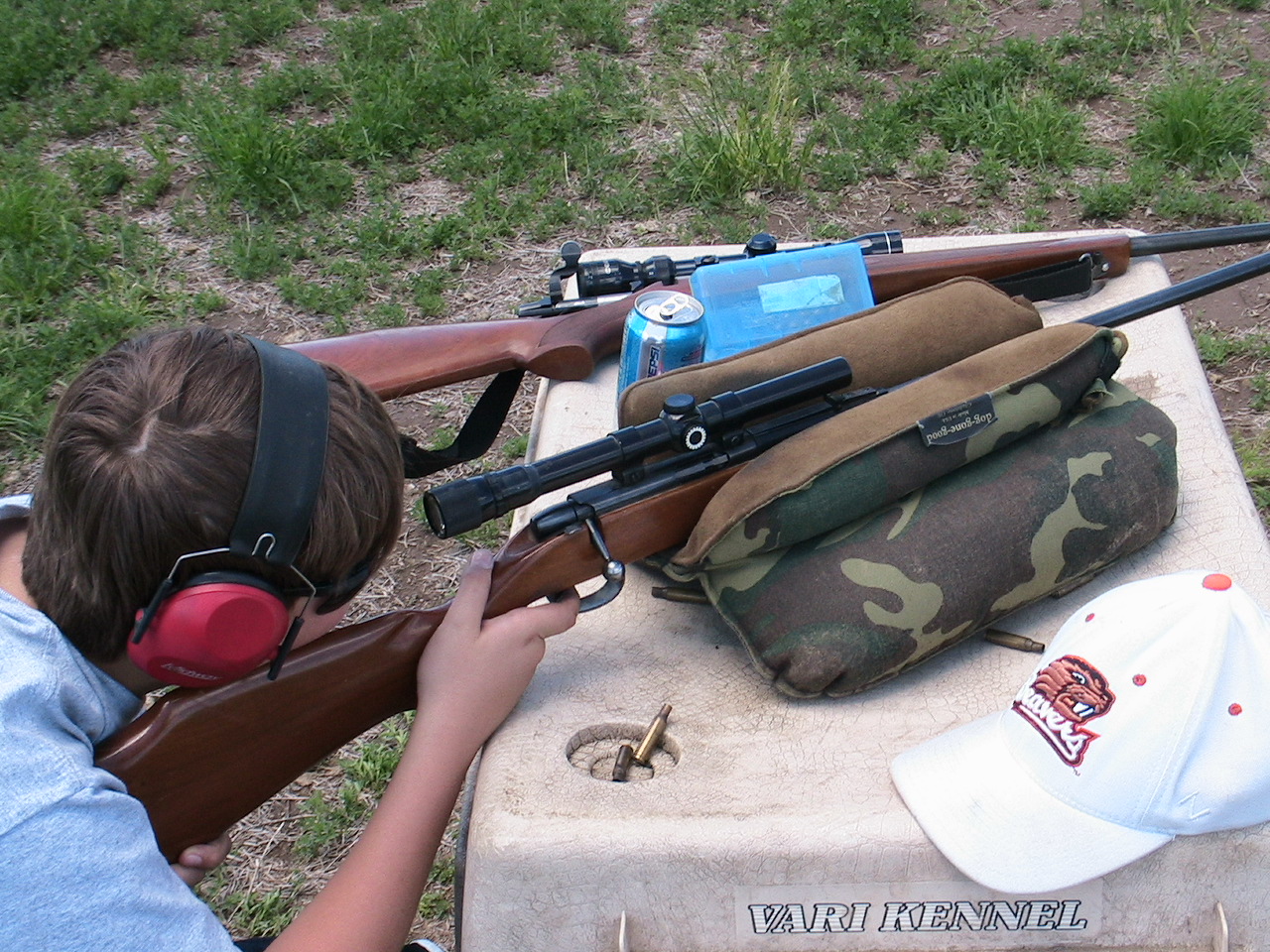 Vintage scope made longer shots tricky
Vintage scope made longer shots tricky
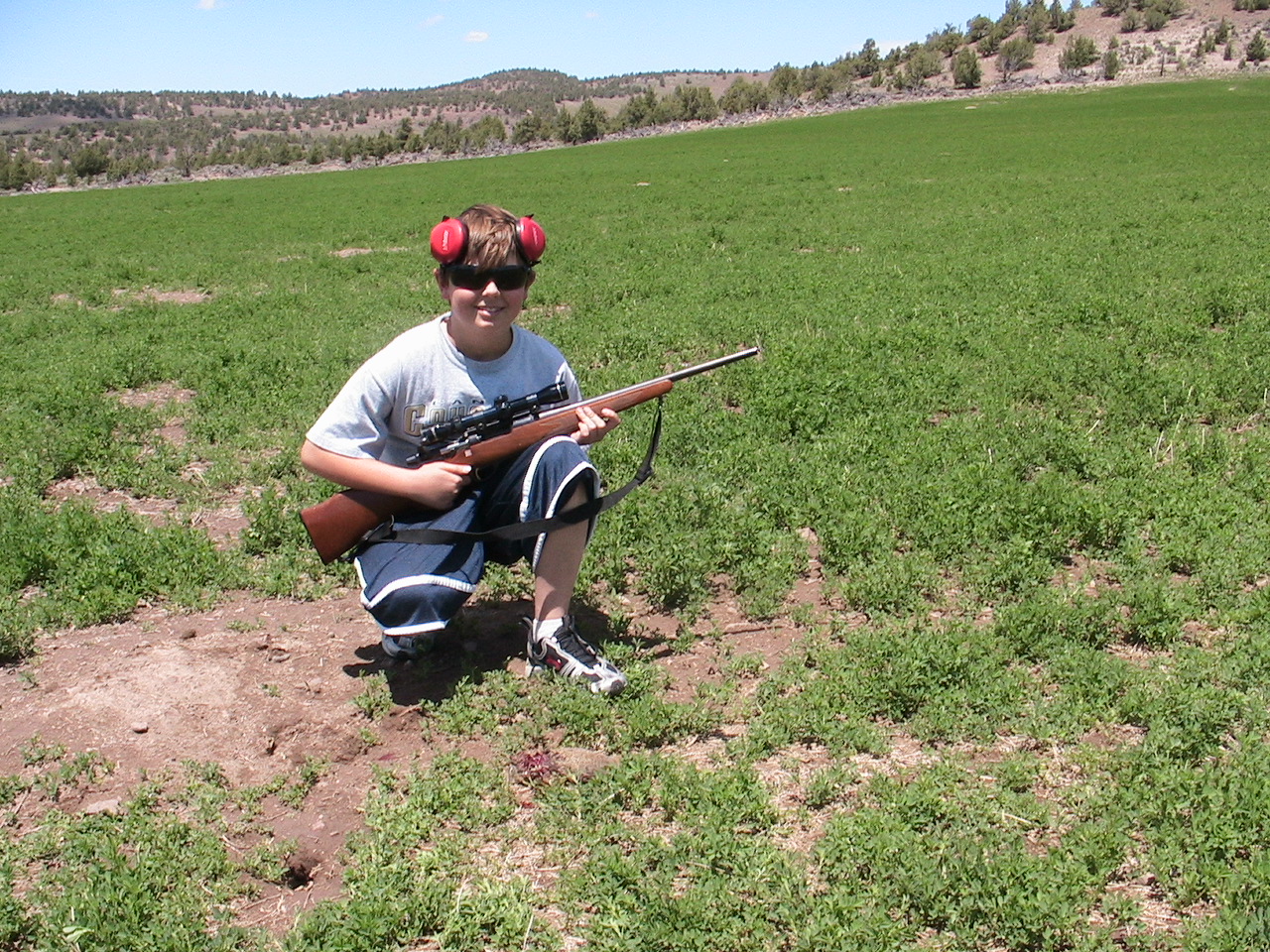 Yup, the 222 sure makes a mess…
Yup, the 222 sure makes a mess…
 …and so does the 5mm!
…and so does the 5mm!
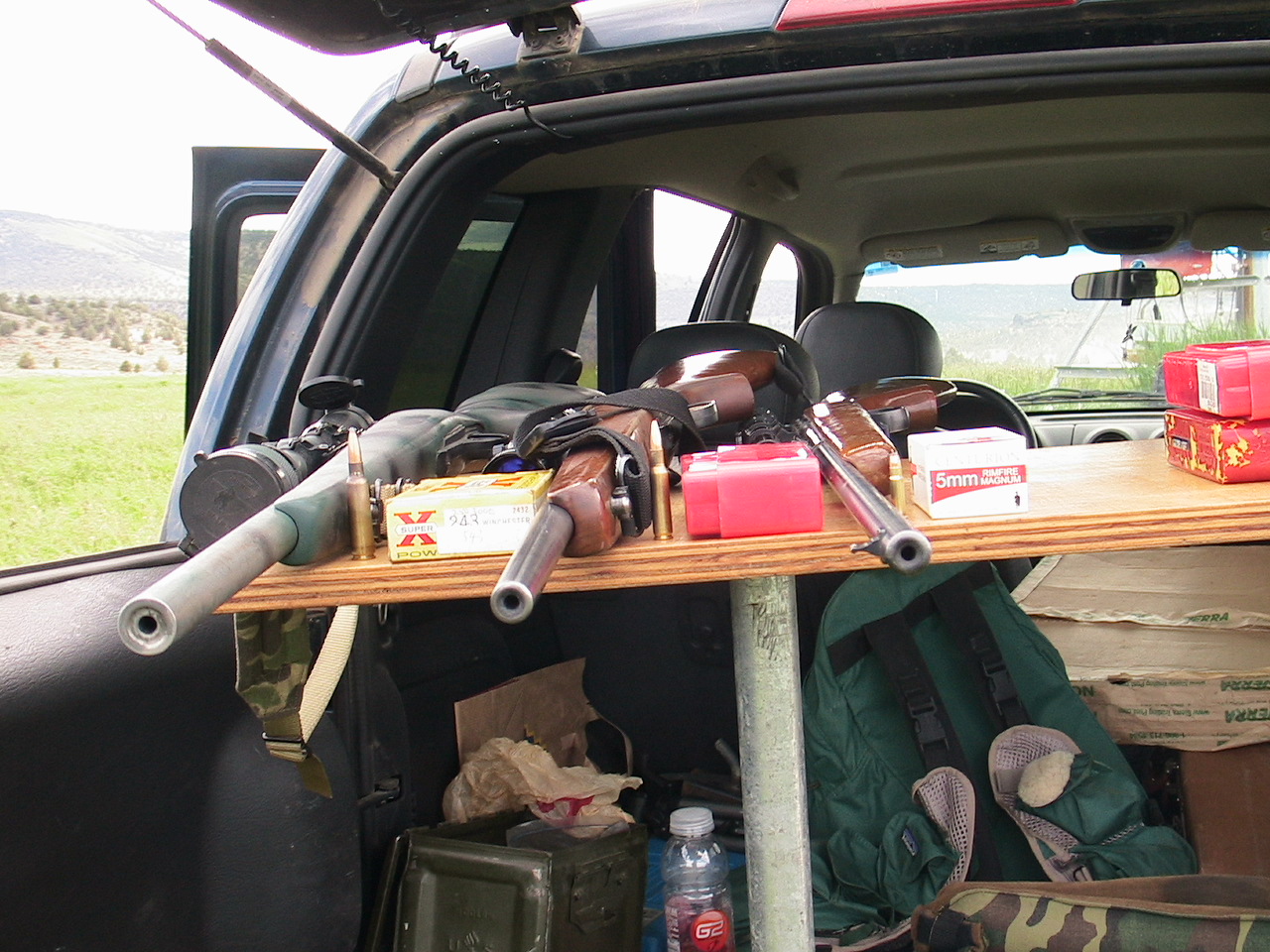 250 Savage, 222 and 5mm lineup
250 Savage, 222 and 5mm lineup
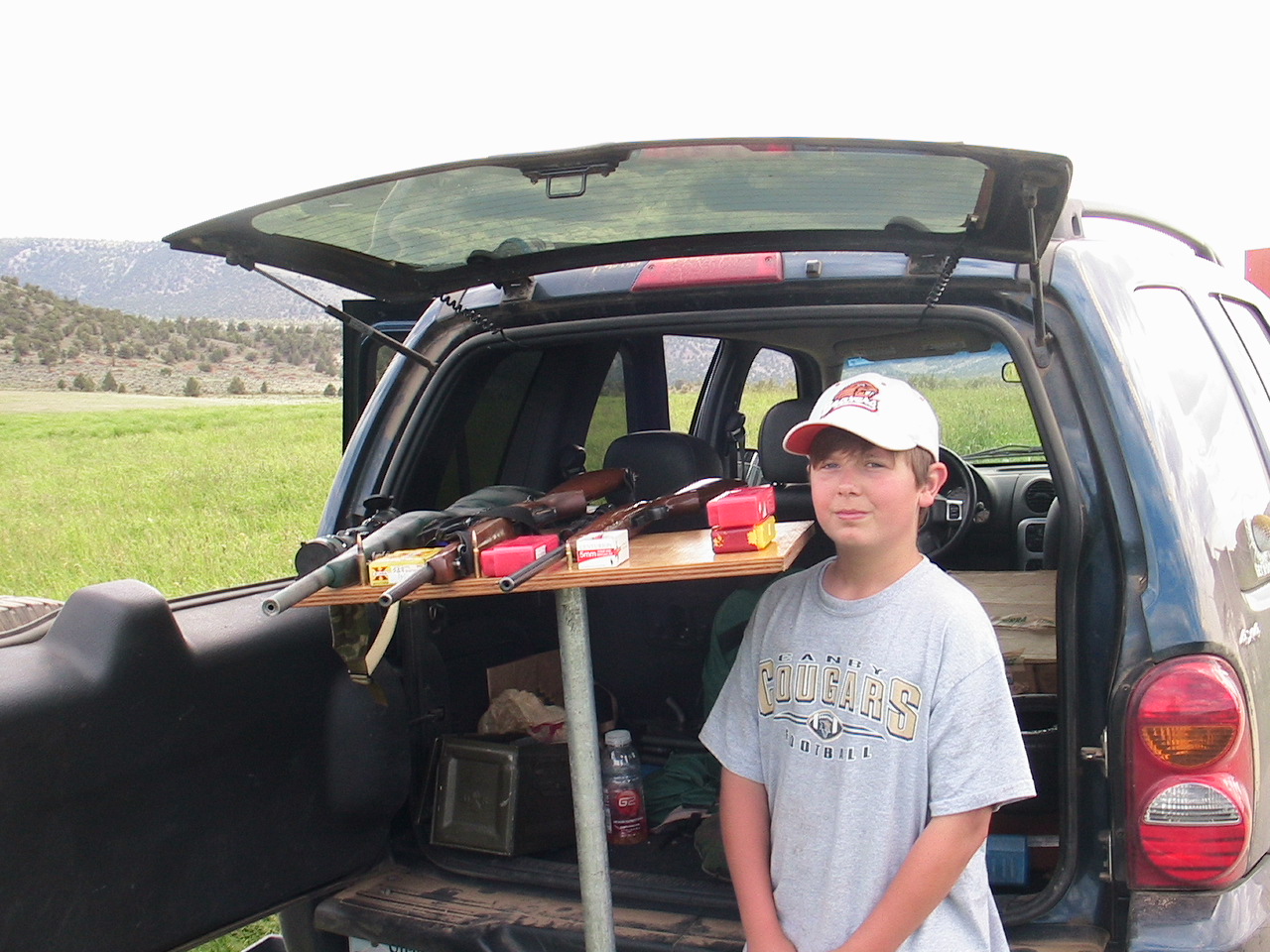 This sure beats school
This sure beats school
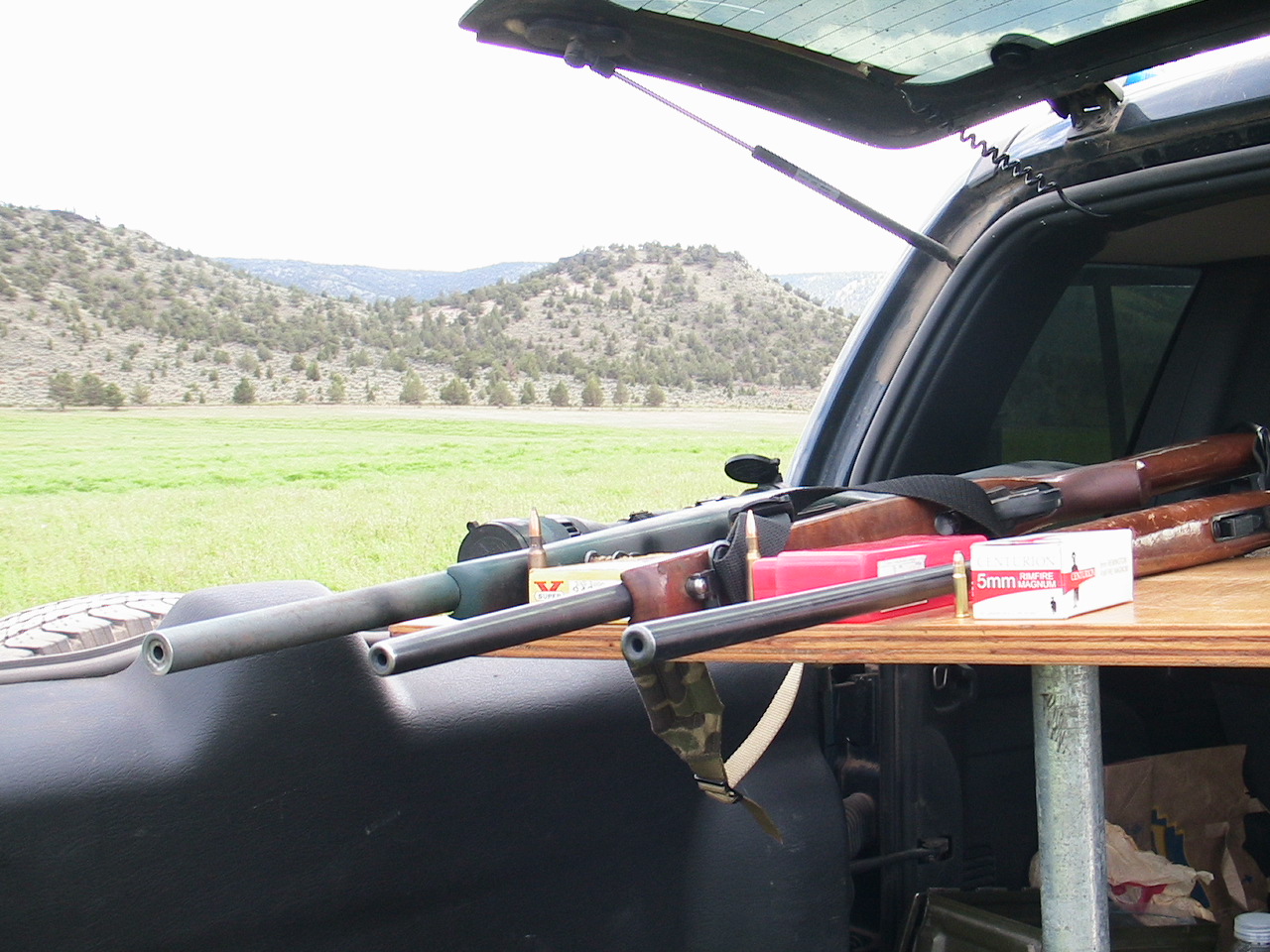 Rats watch out….
Rats watch out….
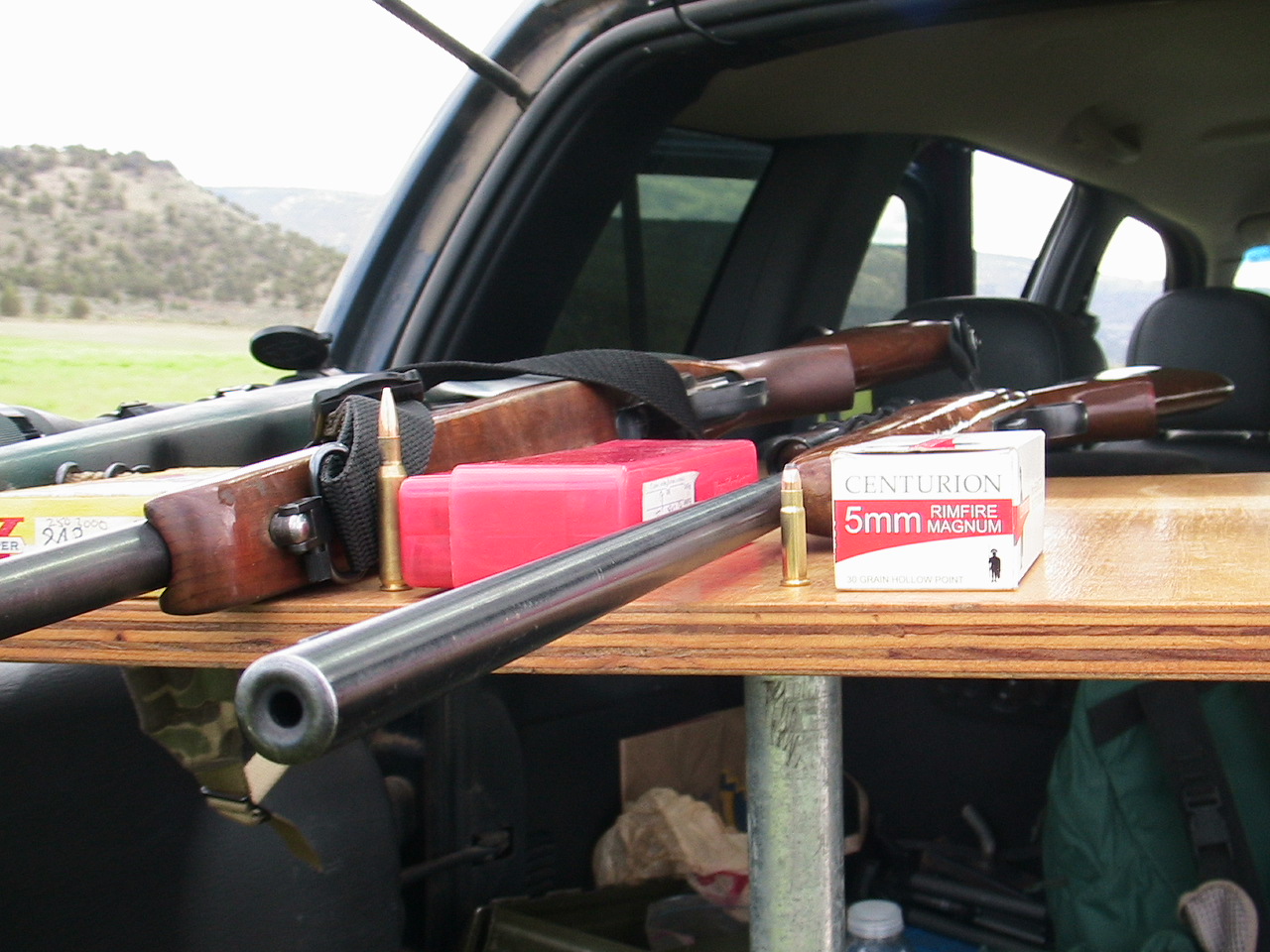 20 calibers rule!
20 calibers rule!
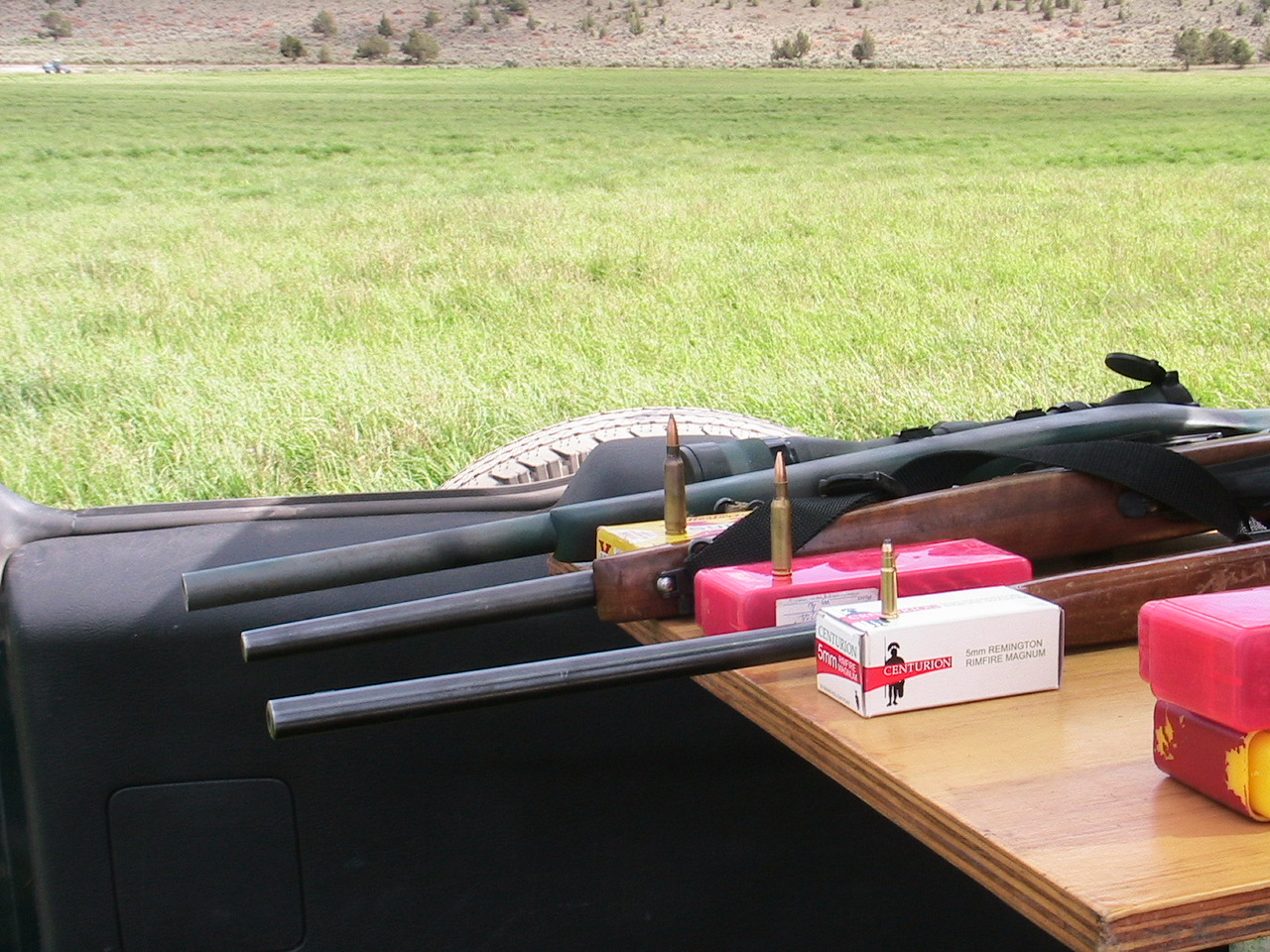 The lineup ….we like the road less traveled!
The lineup ….we like the road less traveled!
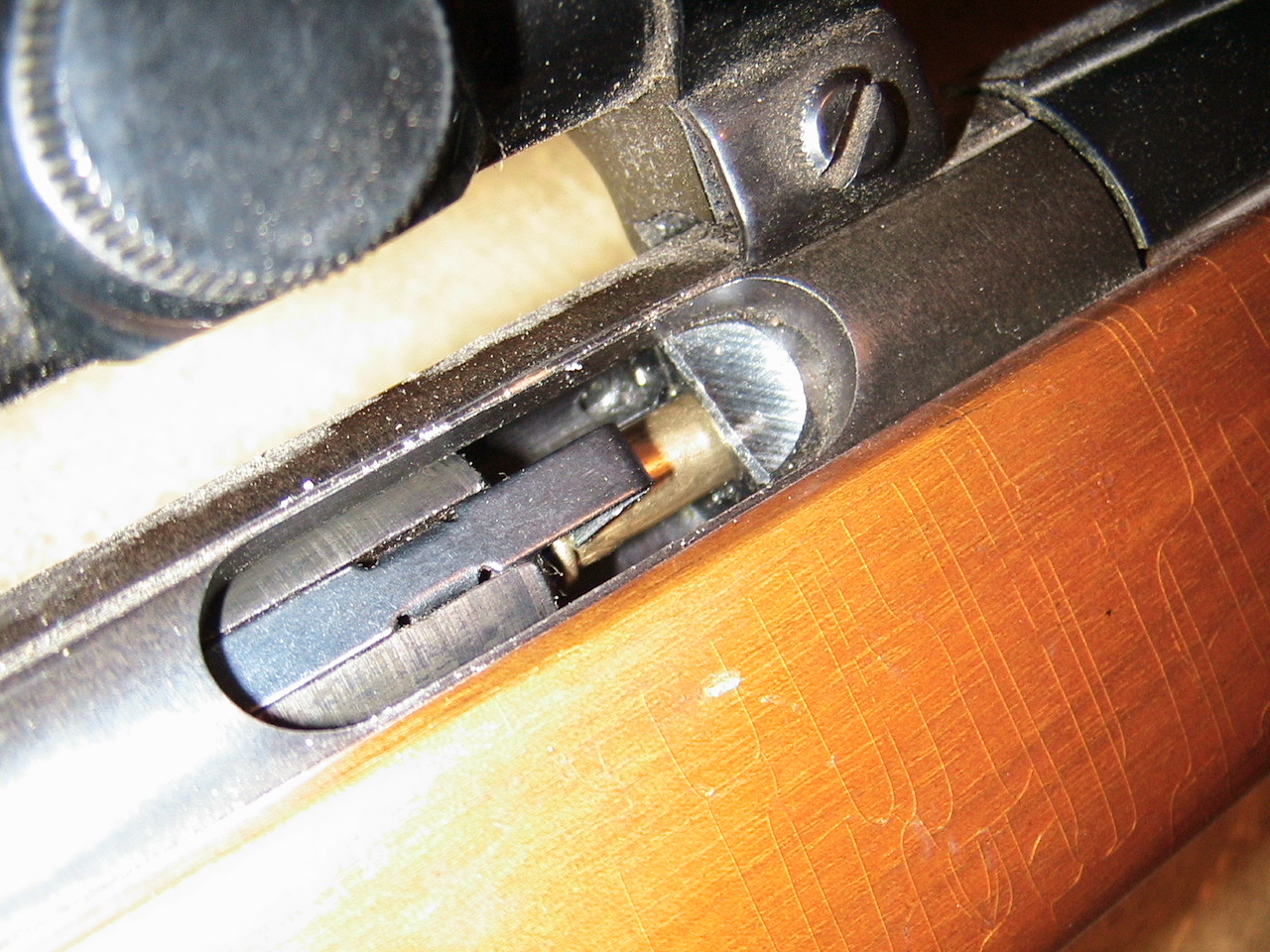 Unconventional secondary extractor
Unconventional secondary extractor
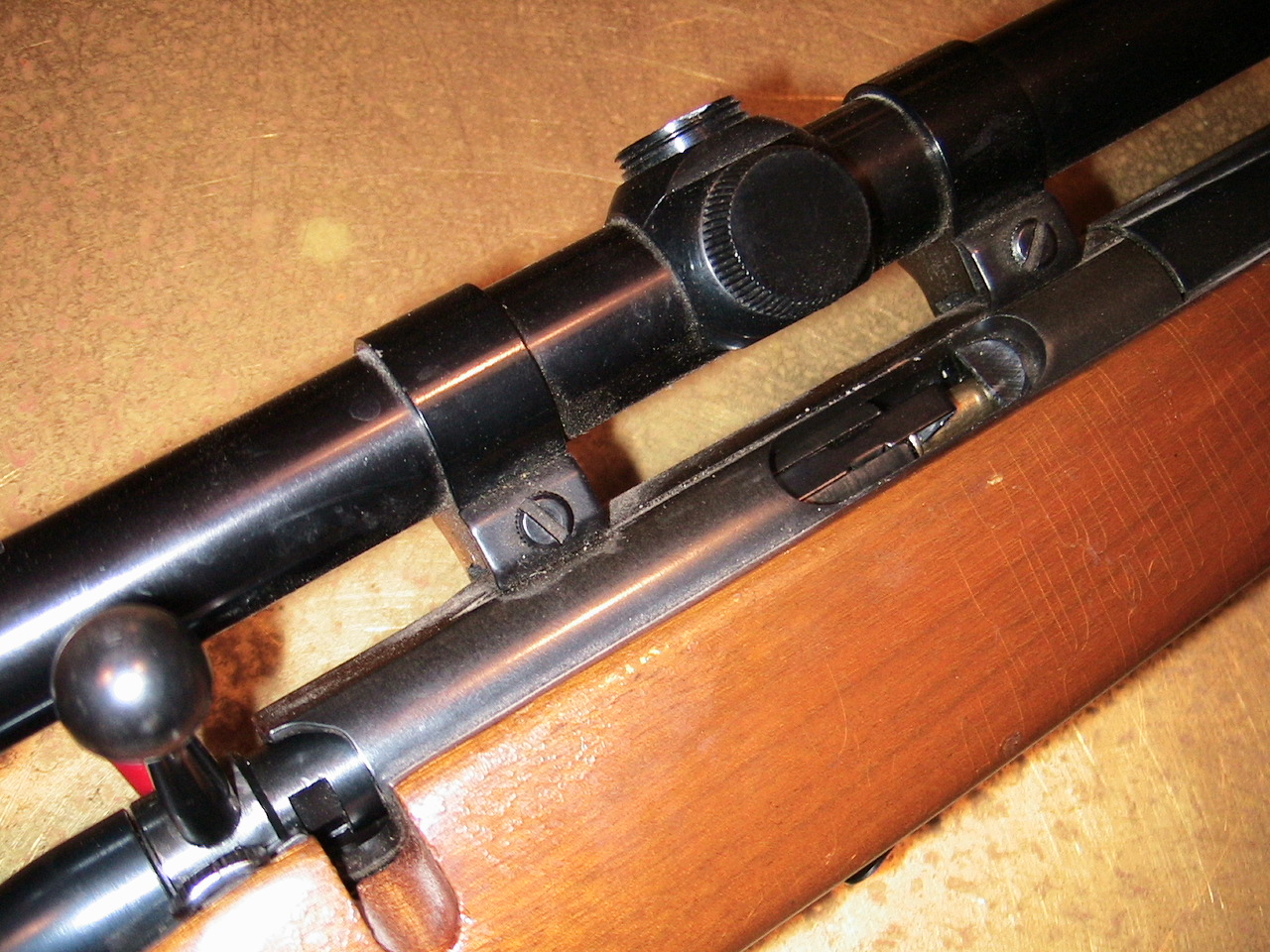 Remington rifles utilized rear locking bolt similar to 788
Remington rifles utilized rear locking bolt similar to 788
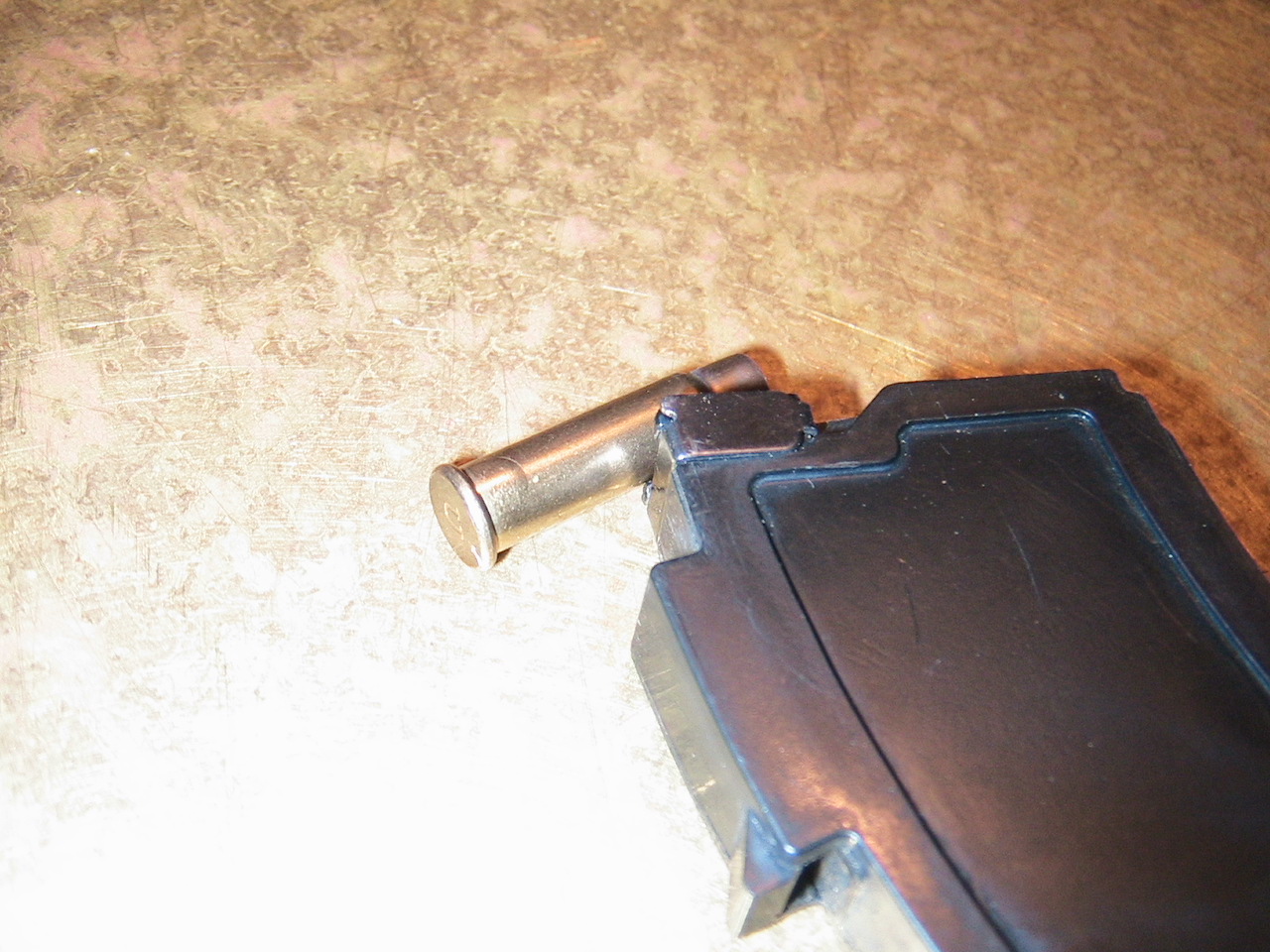 Fired 5mm case with characteristic bubble where primary extractor is located
Fired 5mm case with characteristic bubble where primary extractor is located
 Primary extractor inset into chamber
Primary extractor inset into chamber
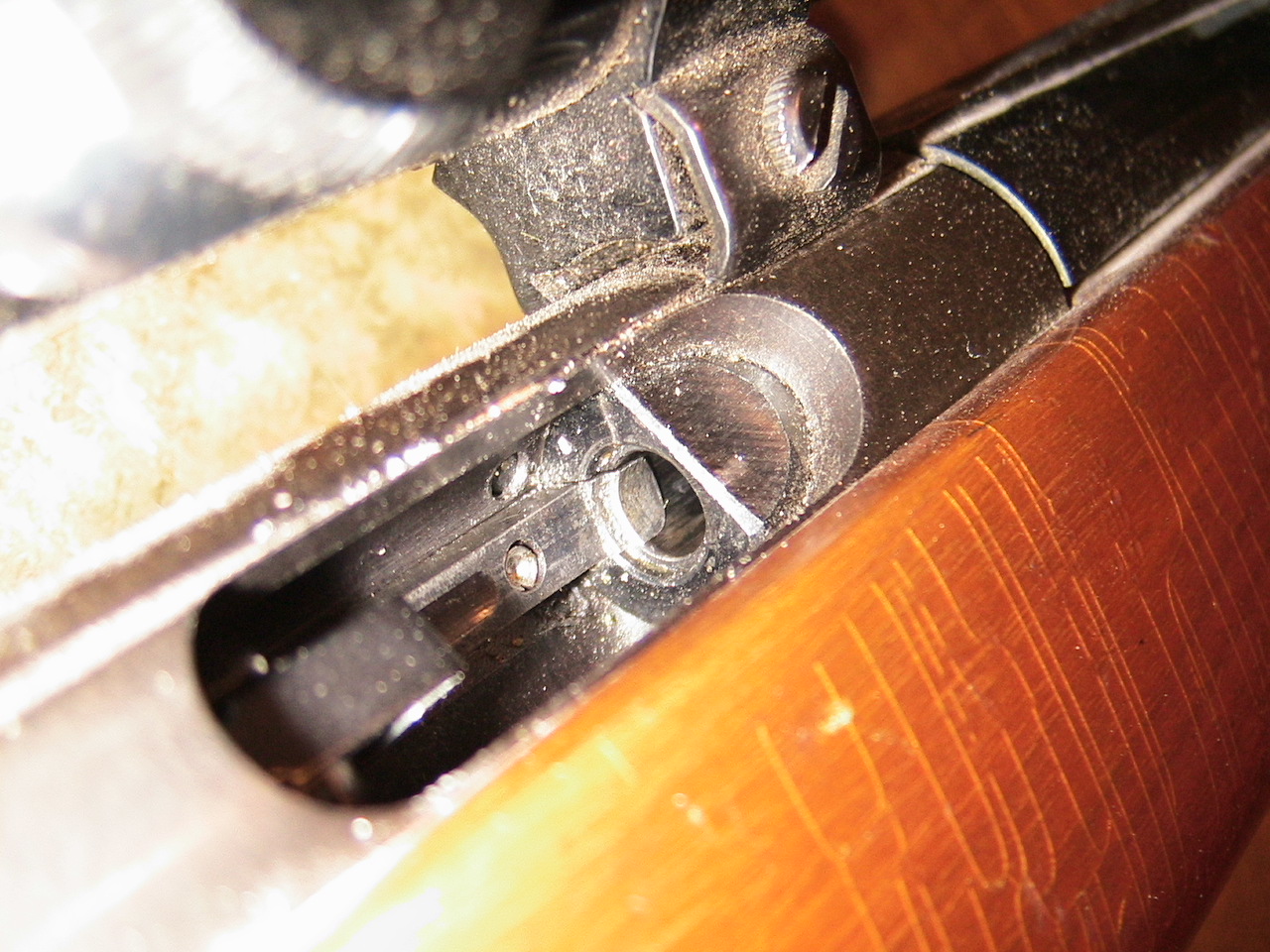 Remington 592 bolt is very substantial for a rimfire
Remington 592 bolt is very substantial for a rimfire
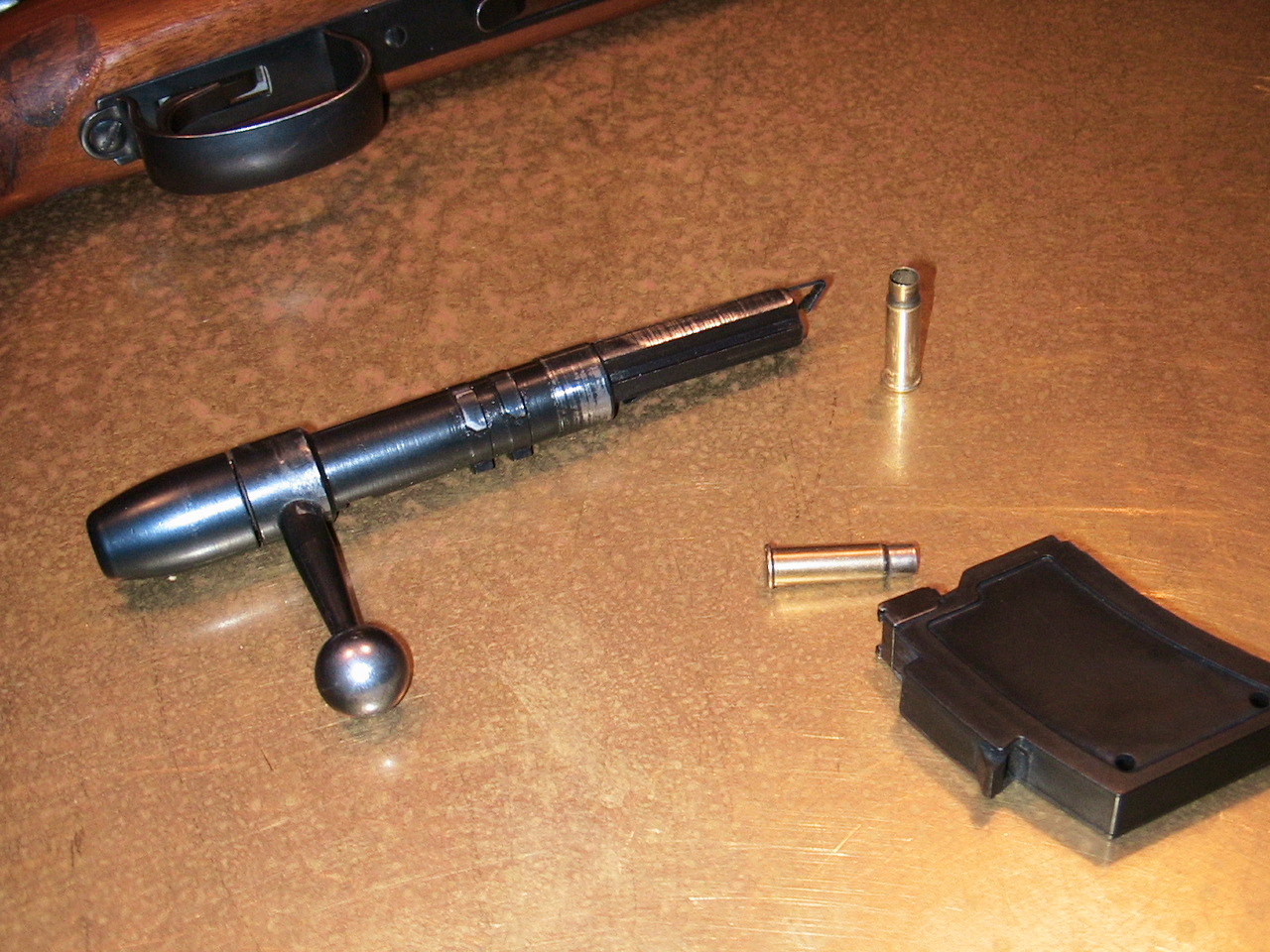 ; Bolt head showing unusual secondary extractor and firing pin
; Bolt head showing unusual secondary extractor and firing pin
Short throw bolt
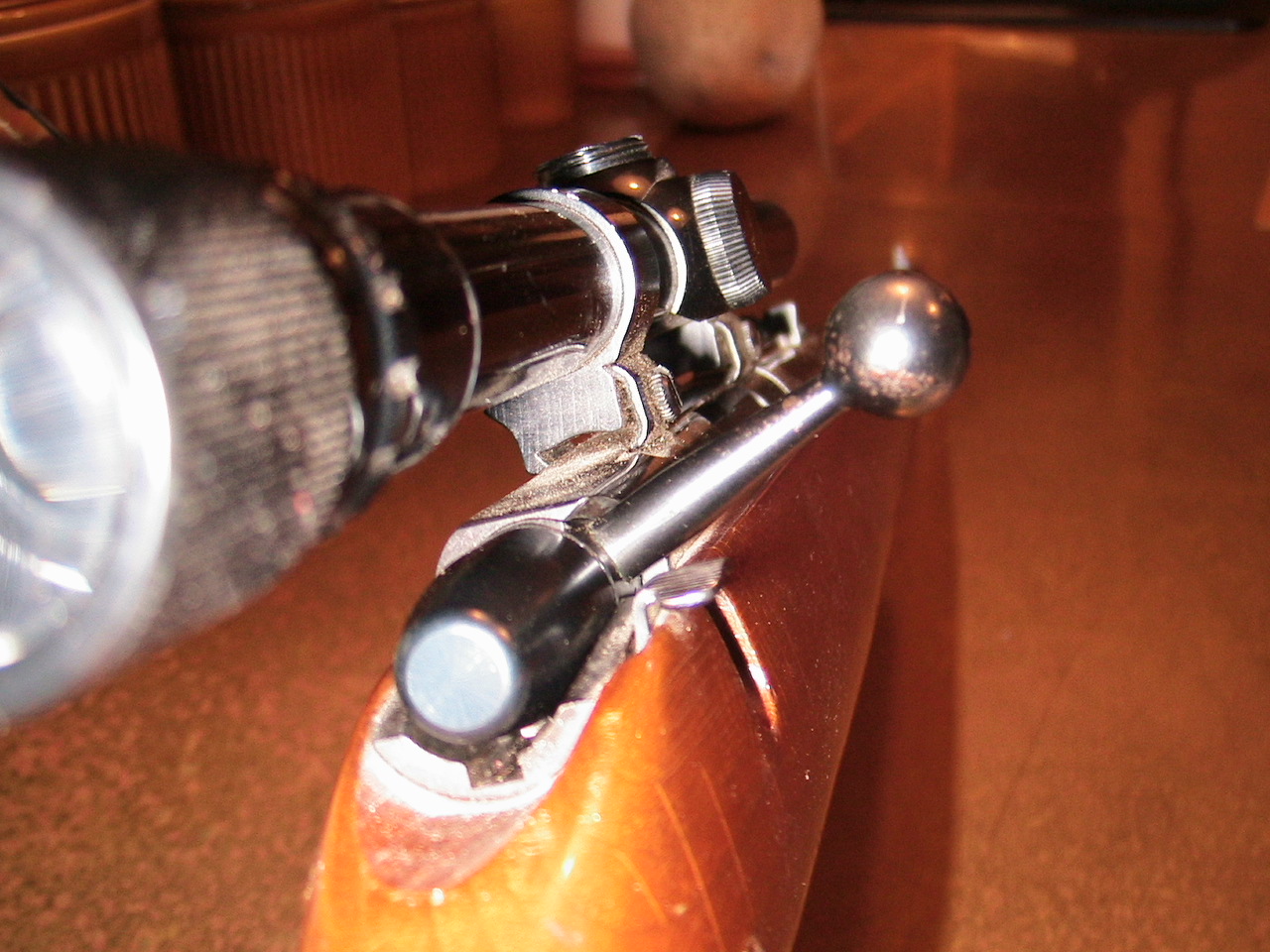 Secondary extractor rides cam surface ceding control to primary extractor for first stage of extraction.
Secondary extractor rides cam surface ceding control to primary extractor for first stage of extraction.